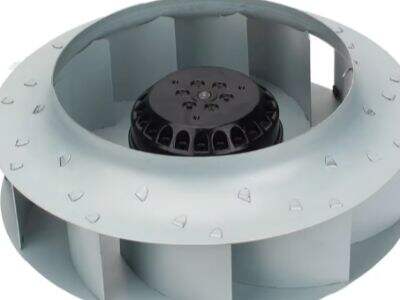Het jy ooit die groot, rond ventilator op die plafond van jou klaslokaal gesien? Hierdie ventilator sirkuleer die lug en help jou om koeler en meer komfortabel te voel. Dit word bekend as 'n sentrifugale ventilator, en so beweeg dit lug rondom in 'n kamer. En vir 'n wyder blik op hoe sentrifugale ventilators werk en waarom dit belangrik is.
Hoe Werk Sentrifugale Ventilators?
Een woord wat baie belangrik is, is doeltreffendheid, of hoe goed iets werk. By sentrifugale ventilators is doeltreffendheid 'n maatstaf van die hoeveelheid lug wat deur die ventilator beweeg word en die hoeveelheid energie wat daarvoor benodig word. 'n Doeltreffender ventilator beweeg 'n groot hoeveelheid lug vir 'n kleinere hoeveelheid energie-uitgawe. Dit is 'n goeie ding omdat dit elektrisiteit spaar en koste laag hou.
Verskillende ventilators het verskillende take. Sommige word byvoorbeeld gebruik om 'n kamer te koel op 'n warme dag, terwyl ander ventilators help om rook of onaangename geure te verwyder. Die tipe ventilator wat jy nodig sal hê, hang af van sy bedoelde doel. Stap een om die regte ventilator te kies is om te weet watter doel jy daarmee wil bereik.
Lugvloei en Druk – Wat dit Beteken in Sentrifuge Ventilators
Kruisvloei-ventilators is 'n tipe ventilator wat lug deur die blower beweeg. Lug gaan binne deur die ventilatorblaaie (ook bekend as impellers), beweeg deur hulle heen en word uitgestoot in die kamer. Die vloei van lug wat deur die ventilator uitgestoot word, is lugvloei, gemeet in kubieke voete per minuut (CFM). Dit vertel ons hoeveel lug die ventilator kan beweeg in 'n tydperk.
Die ventilator veroorsaak druk in die kamer terwyl dit lug duw. En druk is wat lug van een kamer na die volgende duw. Hoe groter die druk, hoe vinniger sal die lug vloei. Die druk wat 'n ventilator genereer, word gemeet met duime watergat (WG). Dit gee ons 'n idee van hoe sterk die ventilator is by lugbeweging.
Ventilatorprestasie en impellerontwerp
Die impeller is die belangrikste komponent van 'n fan. Dit is die deel wat fisies die lug beweeg. Impellers kom in baie verskillende vorms, en elke vorm kan lug op verskillende maniere beweeg. Die vorm van die impeller kan die volume van lug wat 'n fan vir 'n gegewe hoeveelheid energie kan voer, verhoog.
Impellers kom in verskillende vorms, insluitend agterwaarts-gekrom, voorwaarts-gekrom en radiaal. Verskillende vorms het unieke voordele en nadele, wat die doeltreffendheid van die fan beïnvloed. Sommige vorms mag byvoorbeeld beter geskik wees om groot volumes lug vinnig te beweeg, terwyl ander beter is vir energiebesparing.
Hoe om die regte Fan te Kies deur Fan-kromme Analise
Fan-kromme analise kan ons help om die regte fan te kies. Dit laat ons toe om die prestasie van verskillende sentrifugale fans te vergelyk. Fan-krommes vertel ons watter stroom en watter druk 'n fan kan skep by verskillende energieniveaus. Dit is baie nuttige inligting omdat dit ons in staat stel om die tipe fan te kies wat die beste geskik is vir die taak wat voor lê.
Daar is 'n paar belangrike oorwegings om in gedagte te hou wanneer jy 'n ventilator kies. Ons moet oor die bedryfskoste nadenk, hoe lawaaiig die ventilator gaan wees, en hoe dit die omgewing beïnvloed. Ventilatorkurwe-analise laat ons beter keuses maak wat hierdie sleutelbestanddele balanseer.
Waarom Maak Sommige Ventilators (So Veel) Geraas?
Het jy ooit opgemerk hoe sommige ventilators baie luider is as ander? Die geraante vlak in 'n sentrifugale ventilator word bepaal deur verskeie elemente, insluitend die ontwerp van die impeller en die motor, sowel as die spoed van die lugvloed.
Een van die hoofbydraers tot geraante vlakke in 'n silo is lugvloed-turbulensie. Turbulensie kom voor wanneer lug deur 'n ventilator beweeg wat nie ontwerp is om die lug vry te laat vloei nie. Hierdie tipe geraas is baie afleidend en kan dit moeilik maak om te hoor wat net verder as ons liggaam is. Om die geraas te verminder, is dit 'n goeie idee om ventilators te kies wat ontwerp is om lugvloed-turbulensie te minimaliseer.

 EN
EN
 AR
AR
 BG
BG
 HR
HR
 CS
CS
 DA
DA
 NL
NL
 FI
FI
 FR
FR
 DE
DE
 EL
EL
 HI
HI
 IT
IT
 JA
JA
 KO
KO
 NO
NO
 PL
PL
 PT
PT
 RO
RO
 RU
RU
 ES
ES
 SV
SV
 TL
TL
 ID
ID
 SR
SR
 SK
SK
 UK
UK
 VI
VI
 GL
GL
 HU
HU
 TH
TH
 TR
TR
 FA
FA
 AF
AF
 MS
MS
 BE
BE
 BN
BN
 KK
KK
 UZ
UZ
 XH
XH
/images/share.png)
